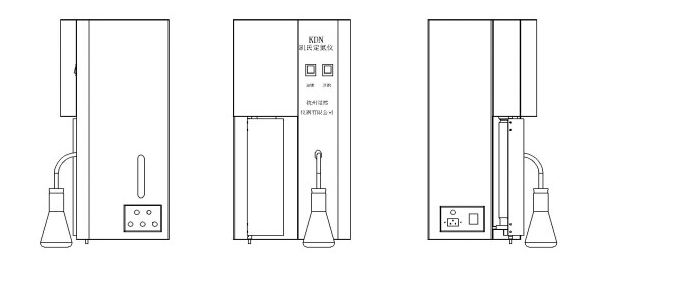High quality 1.5L scale lab spray dryer equipment
Lab scale spray dryer is suitable for the production of in universities, research institutes and food and pharmaceutical chemical enterprises.
Product Description
1. KDN Kjeldahl nitrogen analyzer is an automatic nitrogen measurement distillation system designed according to the classic (Kjeldahl nitrogen) method. The main workflow of the instrument includes: automatic water addition (including automatic water level detection function), automatic alkali addition (button control), manual acid addition (manual configuration), automatic distillation (button control), etc. The instrument is simple to operate; safe and reliable to use; time-saving and labor-saving; suitable for analysis, teaching and research in industries such as grain and oil testing, feed analysis, plant nutrient testing, soil fertilizer testing, medicine, chemical industry, etc. It is an ideal tool for operators .
Working principle (Kjeldahl principle):
Proteins are nitrogen-containing organic compounds. The food is heated and digested with sulfuric acid and catalyst to decompose protein, and the decomposed ammonia combines with sulfuric acid to produce ammonium sulfate. Then the ammonia is released under the action of alkalization and distillation, and the released ammonia gas and water vapor are condensed together through the condenser, and then enters the conical flask containing boric acid. After being absorbed by boric acid, it is titrated with a standard solution of sulfuric acid or hydrochloric acid, and the protein content is obtained by multiplying the consumption of acid by the conversion factor.
Instrument structure and function introduction


2.Schematic diagram on the left and introduction of functions
①Heating cup water level observation port: used to observe the water level in the heating cup inside the instrument.
②Alkali inlet: cut into the required length with the Φ4 silicone tube in the accessories, insert one end into the interface here, and put the other end into the plastic bottle containing the lye.
③Distilled water inlet: cut into the required length with a Φ6 silicone tube in the accessory, insert one end into the interface here, and put the other end into the container with distilled water.
④Distilled water outlet: cut to the required length with a Φ6 silicone tube in the accessories, insert one end into the interface here, and put the other end into the waste liquid recovery container bottle (or directly drain into the sewer). As hot water is discharged here, be careful of hot hands. The switch must be turned off when working. The distilled water must be drained after one day of experiment.
⑤Cooling water inlet: cut into the required length with the Φ6 silicone tube in the accessories, insert one end into the interface here, and the other end to the tap water switch. (Tap water is often used instead of cooling water)
⑥Cooling water outlet: cut to the required length with a Φ6 silicone tube in the accessory, insert one end into the interface here, and put the other end into the waste liquid recovery container bottle (or directly drain it into the sewer).
Note: The first five connecting ports must be inserted tightly to prevent air leakage from affecting the operation. At the same time, lye cannot be packed in glass bottles.

3.Schematic diagram and function introduction on the right
①. Main power switch (with light): Control the main power of the instrument. The power-on light is on.
②. Fuse holder; used to install the fuse of the instrument.
③. Power socket: connect the power with the power cord in the accessories
 online service
online service +86 15960821529
+86 15960821529 kevin@ollital.com
kevin@ollital.com kevinollital@gmail.com
kevinollital@gmail.com +86 15960821529
+86 15960821529 +8615960821529
+8615960821529